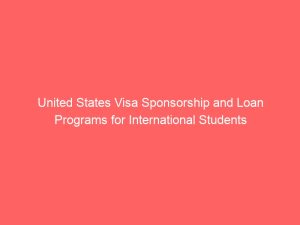For many people moving to the United States, securing a job with visa sponsorship is a major achievement. It means you have a legal path to work in the U.S. and a stable source of income. However, the journey does not end there. Relocating to a new country often comes with significant expenses — from travel and housing to settling into daily life. This is where loans can play a crucial role. The good news is that having visa sponsorship can improve your chances of securing a loan in the United States. In this article, we will explore how to get a loan with visa sponsorship, the types of loans available, and the strategies to improve your approval chances.
Understanding Visa Sponsorship and Its Benefits
Visa sponsorship occurs when a U.S.-based employer agrees to petition for your legal right to work in the United States. The sponsor files necessary immigration documents and sometimes assists with relocation costs. Common work visa types that involve sponsorship include the H-1B visa for specialized workers, the O-1 visa for individuals with extraordinary ability, and the EB-3 visa for skilled workers and professionals.
One often overlooked advantage of having visa sponsorship is the increased trust it builds with financial institutions. Lenders know that a sponsored employee has verified employment and a stable income, which reduces their risk.
Why Loans Are Important for Sponsored Workers
Even with a well-paying job, starting life in a new country requires substantial upfront investment. Typical expenses include airfare, temporary accommodation, security deposits for rental housing, buying furniture, transportation, and in some cases, tuition fees for further education. Without access to credit, these costs can put pressure on your savings. A loan can bridge the gap until you are financially settled.
Types of Loans You Can Get with Visa Sponsorship
Several types of loans may be available to foreign workers who have visa sponsorship in the United States:
Personal Loans
These are unsecured loans that you can use for almost any purpose, including relocation expenses, buying a car, or covering emergencies. Approval often depends on your income, employment stability, and credit profile.
Relocation Loans
Some banks and lenders specialize in loans for people moving to the U.S. These products often have flexible repayment schedules to match the financial adjustment period after relocation.
Auto Loans
If you need a car to commute to work, an auto loan is a common choice. Visa sponsorship can make you more eligible, especially if your employer confirms your contract duration.
Education Loans
Sponsored workers who need additional certifications or degrees in the U.S. may qualify for education loans, particularly if the training is related to their job.
Housing Loans
While more challenging without a U.S. credit history, certain lenders and credit unions work with sponsored employees to offer mortgage or home loan options.
How Visa Sponsorship Improves Loan Approval Chances
Visa sponsorship signals to lenders that you have a legitimate employer, legal work authorization, and a regular income stream. Some employers even have partnerships with banks or credit unions to offer discounted loan rates for their sponsored employees. This can make a significant difference in your application success rate.
Steps to Get a Loan with Visa Sponsorship in the U.S.
Step 1: Gather All Necessary Documentation
Lenders typically require proof of identity, visa status, employment, and income. As a sponsored worker, you should prepare:
- Passport and visa documentation
- Employment contract and sponsorship letter
- Recent pay stubs or proof of salary
- U.S. bank account details if available
Step 2: Research Lenders That Accept Visa Holders
Not all financial institutions offer loans to non-U.S. citizens. Focus on banks, credit unions, and online lenders with a history of serving visa holders. Some international banks with U.S. branches may also offer loans to their existing overseas customers.
Step 3: Compare Loan Terms and Interest Rates
Interest rates can vary widely based on your visa type, income level, and credit profile. Compare multiple offers to ensure you are getting the best deal.
Step 4: Consider a Co-Signer If Needed
If you do not yet have a U.S. credit score, having a co-signer with good credit can improve your chances of approval and lower your interest rate.
Step 5: Submit Your Application
Ensure all documents are accurate and complete before applying. Incomplete applications may lead to delays or rejections.
Step 6: Use Loan Funds Wisely
Once approved, use the funds for the intended purpose. Mismanaging loan money can lead to financial strain and hurt your credit history.
Common Challenges and Solutions
Challenge 1: Lack of U.S. Credit History
Many new arrivals have no U.S. credit score, which can make approval harder. Solution: Use your employment offer and visa sponsorship letter as proof of stability. Some lenders accept international credit histories.
Challenge 2: Short-Term Visa Duration
If your visa has a limited duration, lenders may be hesitant. Solution: Show proof of possible visa renewal or employer support for permanent residency.
Challenge 3: Higher Interest Rates
Without a strong credit profile, you may face higher rates. Solution: Negotiate with lenders or opt for smaller loan amounts to reduce overall interest.
Industries Offering Strong Loan and Visa Sponsorship Support
Certain sectors in the U.S. are more likely to support sponsored workers in getting loans:
Healthcare
Nurses, doctors, and other healthcare professionals are in demand and often have employer support when securing loans.
Information Technology
Tech companies frequently partner with financial institutions to help sponsored employees with relocation and personal loans.
Engineering and Construction
These sectors often involve long-term projects, making sponsored employees more appealing to lenders.
Building Your U.S. Credit Profile After Arrival
Getting a loan is easier when you have a strong credit profile. As soon as you arrive:
- Open a U.S. bank account
- Apply for a secured credit card
- Pay bills on time
- Keep credit utilization low
- Avoid unnecessary debt
Within a year, these habits can significantly improve your chances of getting better loan terms.
Conclusion
Getting a loan with visa sponsorship in the United States is possible, and in many cases, your sponsorship status can work to your advantage. By understanding what lenders look for, preparing strong documentation, and choosing the right type of loan, you can secure the financial support needed to make your transition smoother. Whether you are covering relocation costs, buying a car, or investing in your education, strategic use of loans can help you build a strong foundation for your new life in the United States.



